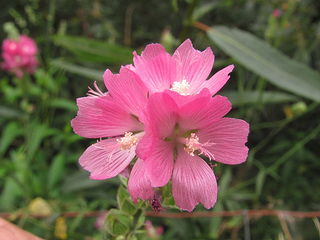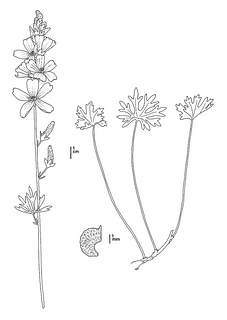(Sidalcea oregana ssp. valida)
 Sidalcea oregana ssp. valida. Photo © Aaron Arthur.
Sidalcea oregana ssp. valida. Photo © Aaron Arthur.
 Sidalcea oregana ssp . valida. CDFW illustration by Mary Ann Showers. (Click to enlarge)
Sidalcea oregana ssp . valida. CDFW illustration by Mary Ann Showers. (Click to enlarge)
Kenwood Marsh checkerbloom is a California endangered plant species, which means that killing or possessing the plant is prohibited by the California Endangered Species Act (CESA). Kenwood Marsh checkerbloom is also listed as endangered under the federal Endangered Species Act. Kenwood Marsh checkerbloom is a perennial herb in the mallow family that has been found in freshwater marshes in Sonoma County. Flowers are deep pink and typically bloom from late June to September, and the plant grows from three to four feet tall.
At the time of this webpage posting, the California Natural Diversity Database lists two occurrences of Kenwood Marsh checkerbloom that are presumed to exist. One occurrence, at Kenwood Marsh, contains three colonies, and the second, in Knight’s Valley, contains one colony. The Kenwood Marsh occurrence was last surveyed in 2008, while the Knight’s Valley occurrence has not been surveyed since 1998. While there is no permanent conservation easement in place at either occurrence, the landowner of two colonies at the Kenwood Marsh occurrence has entered into a ten year agreement with the Natural Resources Conservation Service (NRCS) and U.S. Fish and Wildlife Service (USFWS) to provide assistance and funding for habitat management and enhancement supporting Kenwood Marsh checkerbloom.
The largest threat to Kenwood Marsh checkerbloom is altered hydrology resulting from the diversion of water from a Sonoma Creek tributary stream for agricultural purposes. This resulted in the loss of a water source for Kenwood Marsh. Kenwood Marsh checkerbloom was threatened by grazing and trampling from cattle until 2000, when grazing was discontinued. Since then, Kenwood Marsh checkerbloom has been threatened by competition with nonnative plants that were able to establish. The occurrence at Kenwood Marsh is also threatened by deer, slugs, snails, spittlebugs, and small rodents. Additional threats include loss of populations due to a stochastic event, reduced genetic variation leading to loss of fitness, and climate change.
In order to ensure the continued existence of Kenwood Marsh checkerbloom, the NRCS, USFWS, and CDFW should continue to work in cooperation with private landowners to continue management of existing occurrences. Invasive plants should be controlled, and seed should be collected and propagated to initiate an outplanting experiment. Willows should be cut back to allow Kenwood Marsh checkerbloom to expand into potential habitat. Additionally, a conservation easement should be placed on both occurrences. The Knights Valley occurrence should be visited and surveyed, and a management plan for the site should be prepared.
CDFWmay issue permits for Kenwood Marsh checkerbloom pursuant to CESA, and you can learn more about the California laws protecting Kenwood Marsh checkerbloom and other California native plants. Populations of Kenwood Marsh checkerbloom occur in CDFW’s Bay Delta Region. More information is also available from the U.S. Fish and Wildlife Service Species Profile for Kenwood Marsh Checkerbloom.
Updated 01/15/2014